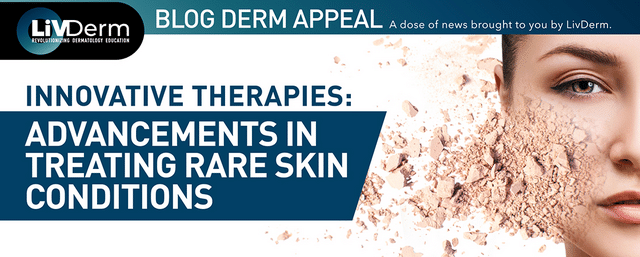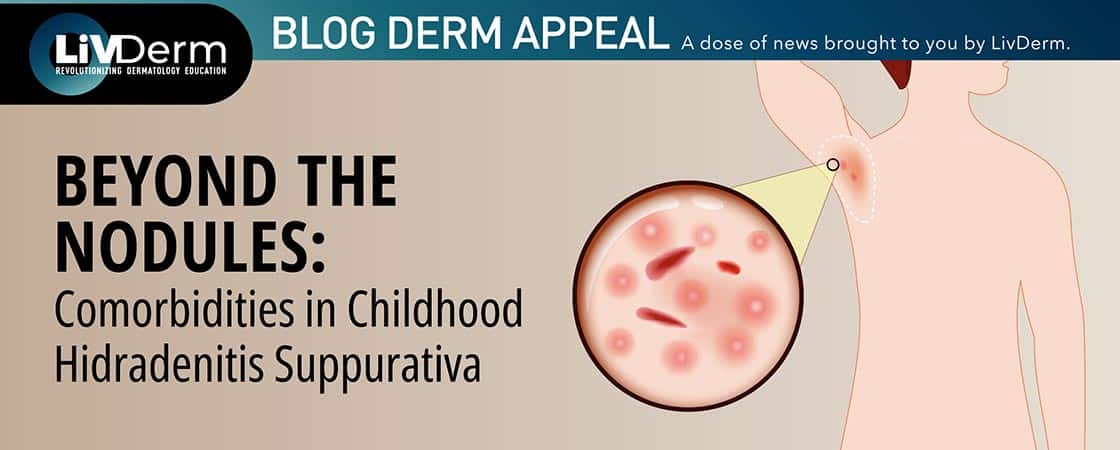While a considerable amount of dermatological research is dedicated to addressing prevalent conditions such as acne and eczema, ongoing efforts persist in combating rare skin disorders. In observance of Rare Disease Day on February 29, we spotlight some of the newly developed and emerging therapies that offer hope and potential relief to individuals grappling with some of the most uncommon skin conditions. Delving into these innovative treatments can help provide insight into the significant impact such progress can have on patients and their families.
Understanding the Impact of Rare Skin Diseases
Rare skin diseases include over 800 diseases affecting more than 6.8 million people around the world. Living with a rare disease can have a profound impact on individuals and their families. Unlike some of the more common skin conditions, rare diseases are often accompanied by unique challenges, including a lack of medical knowledge, few, if any, treatment options, not to mention the financial burden due to the higher costs of specialized treatments. In addition to the physical implications, these rare disorders can also be isolating and cause significant emotional and mental distress for the individual. This is one of the reasons why understanding the impact of living with a rare disease is crucial for fostering empathy, driving research initiatives, and ultimately improving the quality of life for those affected.
Breakthrough Treatments for Rare Skin Diseases
In recent years, we have witnessed remarkable breakthroughs across the dermatologic spectrum, including those targeting rare skin diseases. This has brought newfound hope to individuals facing previously unmet medical needs. These therapies exhibit the potential to revolutionize the landscape of rare skin disorder management, offering a pivotal turning point in the pursuit of improved outcomes and enhanced quality of life. As we explore these groundbreaking advancements, it becomes evident that the relentless pursuit of scientific innovation is paving the way for transformative solutions for rare conditions.
Gene Therapy: Revolutionizing Treatment Approaches for Inherited Skin Disorders
The gene therapy approach has the potential to revolutionize the treatment of inherited skin disorders by targeting and correcting specific genetic mutations. Where traditional treatment approaches typically focus on managing the symptoms of the disease, gene therapy addresses the underlying cause by directly targeting the faulty genes responsible. In doing so, gene therapy offers a more long-term solution and significantly helps in improving the patient’s quality of life.
Epidermolysis Bullosa
Epidermolysis Bullosa (EB) constitutes a group of uncommon genetic disorders marked by the susceptibility of the skin and mucous membranes to blistering and fragility. This condition manifests in various areas of the body, including the mouth, esophagus, lungs, and nails. Swift and accurate diagnosis is crucial due to the severity of the ailment which often presents in infancy. It is often referred to as the ‘Butterfly Disease,’ as individuals afflicted with it encounter heightened skin fragility, making them prone to painful blistering even from the gentlest of touches encountered in daily life. The disorder encompasses distinct types, some more prevalent than others, and each is distinguished by a specific gene mutation that influences the location of blistering and which layer of the skin is adversely affected.
After years of research and clinical trials, last year marked a huge milestone for those living with this highly debilitating skin condition – the arrival of two U.S. Food and Drug Administration (FDA) approvals. The first, Krystal Biotech’s VYJUVEK™ (beremagene geperpavec-svdt), was approved in May 2023 and is the first-ever topical gene therapy for Dystrophic Epidermolysis Bullosa (DEB). This vector-based gene therapy is a non-invasive, topical, and redosable therapy that has been approved for patients six months and older with recessive or dominant DEB. It targets the collagen type VII alpha 1 chain (COL7A1) gene aiding in its replication in order to facilitate wound healing.
Later, in December, the FDA approved Cheisi’s FILSUVEZ® (birch triterpenes), a topical gel for the treatment of partial thickness wounds in patients six months and above with DEB and Junctional Epidermolysis Bullosa (JEB). FILSUVEZ can be administered at home and applied to the wound at each dressing change.
“These approvals are not only a landmark victory for individuals living with EB and their families, but also a huge milestone for the rare disease community at large”.
Michael Hund, CEO, EB Research Partnership (EBRP)
In November 2023, the FDA also accepted and granted Priority Review for the Biologics License Application (BLA) of Abeona Therapeutics’ Pz-cel (prademagene zamikeracel) for recessive DEB. The acceptance was based on the Phase 3 VITAL study which demonstrated that a one-time application of pz-cel on large and chronic wounds delivered sustained wound healing and pain reduction in patients with RDEB. Pz-cel is investigational autologous, COL7A1 gene-corrected epidermal sheets designed to incorporate the functional collagen-producing COL7A1 gene into a patient’s own skin cells. The FDA has set a target date of May 25, 2024, as per the Prescription Drug User Fee Act (PDUFA).
Microcystic Lymphatic Malformation
Microcystic Lymphatic Malformation (LM) is a rare debilitating genetic disease that is caused by the dysregulation of the PI3K/mTOR pathway. With Microcystic LM, the soft tissue lymphatic vessels diffuse and emerge through the skin barrier causing the lymph fluid (lymphorrhea) to leak and bleed. This in turn can lead to common infections as well as cellulitis. Currently, there are no FDA-approved treatments for Microcystic LM, a condition that is believed to affect approximately 30,000 people in the U.S.
In March 2023, Palvella Therapeutics announced its positive topline results from its study of QTORIN 3.9% anhydrous rapamycin gel (QTORIN rapamycin). The study included 12 participants who were asked to use QTORIN rapamycin once a day for 12 weeks. At the end of the 12 weeks, all participants demonstrated improvement on both the Clinician Global Impression of Change (CGI-C) as well as the Patient Global Impression of Change (PGI-C) scales.
A Phase 3 study of QTORIN rapamycin is planned pending further interactions with the FDA, which has granted Orphan Drug and Fast Track Designations to QTORIN rapamycin for the treatment of Microcystic LM. The European Medicines Agency (EMA) has also granted Orphan Drug Designation to QTORIN rapamycin.
James R. Treat, MD, pediatric dermatologist at Children’s Hospital of Philadelphia and study investigator, states “People living with Microcystic LMs face daily challenges and frequent, sometimes life-threatening hospitalizations due to cellulitis. Current treatments are inadequate, invasive, and do not address the underlying mechanisms of this debilitating disease. The encouraging results from the Phase 2 study of QTORIN™ rapamycin build upon the large, growing evidence base supporting targeted therapeutic intervention of Microcystic LMs via the mTOR pathway.”
Pansclerotic Morphea
A very rare disease, disabling pansclerotic morphea is characterized by severe skin lesions and poor wound healing which can lead to deep scarring of all layers of the skin and muscle. As this occurs, the muscles harden and cause the joints to stiffen which can in turn lead to reduced mobility. A study led by researchers affiliated with the National Institute of Health (NIH), discovered that all four of their subjects had genomic variants in the STAT4 gene, a protein that plays a role in fighting infection and controlling important aspects of wound healing. This resulted in an overactive STAT4 protein causing impairment of their wound-healing that worsened over time. Researchers treated these patients with a Janus kinase (JAK) inhibitor, ruxolitinib, in an effort to target another protein in the inflammatory pathway and found that patients’ rashes and ulcers dramatically improved, meaning this could be a way forward for this disease.
According to Dan Kastner, MD, PhD, NIH distinguished investigator and head of NHGRI’s Inflammatory Disease Section, “The findings of this study open doors for JAK inhibitors to be a potential treatment for other inflammatory skin disorders or disorders related to tissue scarring, whether it is scarring of the lungs, liver or bone marrow.”
Supportive Care and Psychological Well-being
Coping with rare skin diseases requires a multifaceted approach extending beyond medical interventions. Supportive care plays a vital role when facing the unique challenges associated with some of these rare conditions. This is often found in dedicated support groups where patients and their families can gain a sense of community, fostering empathy and understanding among those experiencing similar circumstances. Additionally, the mental health aspects of living with a rare skin condition are significant, and therefore, addressing psychological well-being becomes an integral component of a multifaceted, comprehensive care approach.
Hope for Patients with Rare Skin Diseases
It is thanks to extensive research and technological innovations that dermatologists and scientists have been able to better understand the underlying causes of some of these rare skin conditions, all of which have paved the way for the development of targeted therapies and personalized treatment approaches. These significant advances have provided much-needed hope for patients and their families, opening up new options and improving quality of life.
The collaborations between researchers, pharmaceutical companies, and patient advocacy groups have also played a pivotal role in accelerating progress in the field and we can expect even more breakthroughs in the future that will further improve treatment outcomes.
Sources:
- RSDB: A rare skin disease database to link drugs with potential drug targets for rare skin diseases
- Krystal Biotech Receives FDA Approval for the First-Ever Redosable Gene Therapy, VYJUVEK™ (beremagene geperpavec-svdt) for the Treatment of Dystrophic Epidermolysis Bullosa
- Chiesi Global Rare Diseases Receives FDA Approval for FILSUVEZ® (birch triterpenes) topical gel for the Treatment of Epidermolysis Bullosa
- https://www.ebresearch.org/ebrp-2023.html
- Palvella Therapeutics Announces Positive Topline Results from Phase 2 Study of QTORIN™ 3.9% Rapamycin Anhydrous Gel (QTORIN™ rapamycin) for the Treatment of Microcystic Lymphatic Malformations, a Serious, Rare Genetic Skin Disease with No FDA-approved Therapies
- QTORIN Rapamycin Gets Positive Topline Results for Rare Skin Disease Treatment
- Abeona Therapeutics Announces FDA Accepts and Grants Priority Review for Pz-cel Biologics License Application (BLA)
- NIH scientists find treatment for rare genetic skin disorder

















